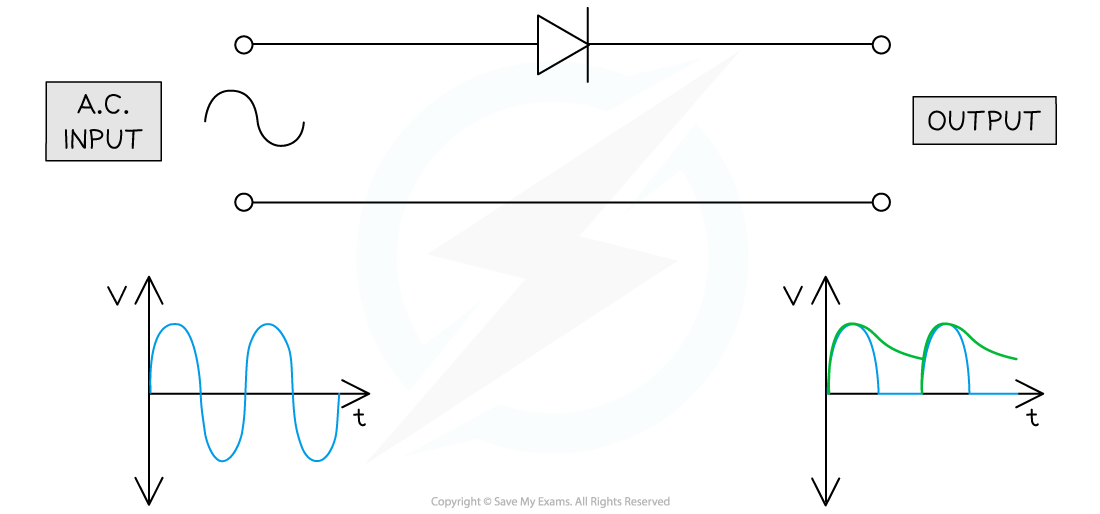Investigating Diode Bridges
Aim of the Experiment
- The aim of the experiment is experimentally verify a half-bridge rectifier will produce partial DC output from AC input and a full wave bridge rectifier will produce near complete DC output from AC input
Variables:
- Independent variable = Input voltage (Alternating Current)
- Dependent variable = Output voltage (Direct Current)
Equipment List
- Step down transformer
- Diode bridge
- Single diode
- Capacitor (330 μF or 50 μF)
- Resistor
- Multimeter
- Oscilloscope
- Connecting wires etc.
- Resolution of measuring equipment:
- Oscilloscope resolution = 8-bit resolution or better
- Step-down transformer = 220V to 6V AC
- Multimeter
- Ammeter setting = 0.01 A
- Voltmeter setting = 0.01 V
Methods
Half Wave Rectification

Experimental set-up for investigating half-wave rectification
- Study the above circuit diagram carefully before setting up the appropriate circuit
- Connect the single diode to the step-down transformer and resistor in circuit
- Connect the resistor to the step-down transformer and the oscilloscope in parallel across the resistor
- Before connecting and turning on the 220 V alternating current (AC) source, voltmeters and ammeters may be set up in appropriate locations to investigate points of interest such as across the diode or the output of the step-down transformer
- However, the oscilloscope is the most crucial measuring equipment for this experiment and is the only truly necessary measurement required for this practical if the circuit is set-up appropriately
- Connect the step-down transformer to the 220 V AC source
- Observe the oscilloscope and look at the voltage reading to confirm partial Direct Current (DC) output (half-wave rectification)
Full Wave Rectification

Experimental set-up for investigating full-wave rectification
- Study the above circuit diagram carefully before setting up the appropriate circuit
- Connect the components of the diode bridge ensuring that the necessary parallel and series diodes are connected so that they run alternatively during the opposite phases of alternating current
- Connect the opposite edges of the diode bridge to the transformer making sure that there is an individual diode facing towards and one facing away from both junctions
- Connect the capacitor and resistor in parallel with their outer connections to the points of the diode bridge where one point of the diode bridge has both diodes facing towards the junction and the opposite point where both of the diodes are facing away from the junction
- Connect the oscilloscope in parallel across the resistor to measure the voltage across that component
- Before connecting and turning on the 220 V AC source, voltmeters and ammeters may be set up in appropriate locations to investigate points of interest such as across the diode bridge, over the smoothing capacitor or the output of the step-down transformer
- However, the oscilloscope is the most crucial measuring equipment for this experiment and is the only truly necessary measurement required for this practical if the circuit is set-up appropriately
- Connect the 220 V AC source to the step-down transformer
- Observe the oscilloscope and look at the voltage reading to confirm DC output
Analysis of Results
- The output of the oscilloscope for half-wave rectification should be similar to the following output:

The green line shows how the capacitor creates a smoothing effect that brings the output of the single diode closer to DC output
- The output for the oscilloscope for full-wave rectification should be similar to the following output:

The green line shows how the capacitor creates a smoothing effect that brings the output of the diode bridge closer to DC output
- Notice the smoothing effect which comes from the capacitor in the circuit and makes the output more like DC in nature
Evaluating the Experiment
Systematic Errors:
- The voltmeter and ammeters should start from zero, to avoid zero error in the readings
Random Errors:
- In practice, the voltmeter and ammeter will still have some resistance, therefore the voltages and currents displayed may be slightly inaccurate
- The temperature of the equipment could affect its resistance. This must be controlled carefully
- Taking multiple readings of the current for each component will provide a more accurate result and reduce uncertainties
Safety Considerations
- When there is a high current and a thin wire, the wire will become very hot
- Make sure never to touch the wire directly when the circuit is switched on
- Switch off the power supply right away if burning is smelled
- Make sure there are no liquids close to the equipment, as this could damage the electrical equipment
- The components will get hot especially at higher voltages
Alternatives and Variations
- In the case that an oscilloscope is not available, it may be possible to use a multimeter to check that the output is indeed similar to DC and able to be detected as such
- While the actual voltage pattern will not be visible, this would still allow the DC-like output to be verified and confirm that the diode bridge (full-wave rectification) does work experimentally
- If access to a diode bridge and complete circuit is not possible, then there are often simulations available online which might allow the possibility to do this investigation virtually
